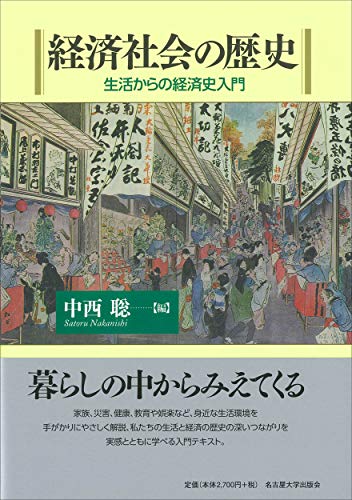3 0 0 0 OA 幕末・明治期畿内肥料市場の展開
- 著者
- 中西 聡
- 出版者
- 北海道大学經濟學部
- 雑誌
- 經濟學研究 (ISSN:04516265)
- 巻号頁・発行日
- vol.47, no.2, pp.281-298, 1997-09
3 0 0 0 OA 近代輸送体系の形成と港湾の性格変化:瀬戸内・山陰地帯を事例として
- 著者
- 中西 聡
- 出版者
- 北海道大学經濟學部 = HOKKAIDO UNIVERSITY SAPPORO,JAPAN
- 雑誌
- 經濟學研究 (ISSN:04516265)
- 巻号頁・発行日
- vol.48, no.3, pp.231-250, 1999-01
2 0 0 0 OA 明治期日本における商船船主
- 著者
- 中西 聡
- 出版者
- 大阪経済大学日本経済史研究所
- 雑誌
- 経済史研究 (ISSN:1344803X)
- 巻号頁・発行日
- vol.4, pp.62-86, 2000 (Released:2019-02-01)
2 0 0 0 OA 地域社会と経営史研究 ―近代日本の視点から―
- 著者
- 中西 聡
- 出版者
- 経営史学会
- 雑誌
- 経営史学 (ISSN:03869113)
- 巻号頁・発行日
- vol.54, no.3, pp.26-37, 2019 (Released:2021-12-30)
1 0 0 0 IR 近代日本における林産地と林業資産家
- 著者
- 中西 聡
- 出版者
- 慶應義塾経済学会
- 雑誌
- 三田学会雑誌 = Mita journal of economics (ISSN:00266760)
- 巻号頁・発行日
- vol.112, no.4, pp.455-489, 2020-01
本稿は, 近代日本の林産地の成立過程を検討し, 各産地の特徴を比較するとともに,そのなかでの主要林業家の動向を考察することで, 近代日本の林業における産業化の特徴を明らかにした。近代日本の林産地では, 主に吉野式造林法が状況に応じて援用されたが, 本来の長伐期で間伐を丁寧に行う高付加価値型の森林ではなく, 伐期を短くして資本回転率を上げた汎用型森林が定着し, 採算性は上がったものの環境への負荷が強い森林となった。This research analyzed the creation of wood resources in modern Japan, com-paring the features of each wood resource and the movement of wealthy individuals within the forestry industry. In doing so, this paper illuminates the particular characteristics of the industrialization of forestry in modern Japan, and explores how forestry managers adopted a modified Yoshino afforestation method in the management of forest resources. The value that the original Yoshino afforestation method added to lumber forests through–regular time inter-vals for gestation with a long cutting down period–did not spread, but a more versatile forestry method that increased capital turnover with a short cutting down period took root. In this way, forestry became profitable in modern Japan, leading to increased environmental damage論説
1 0 0 0 IR 北前船主系汽船船主の多角的経営展開 : 廣海二三郎家を事例として
- 著者
- 中西 聡
- 出版者
- 慶應義塾経済学会
- 雑誌
- 三田学会雑誌 = Mita journal of economics (ISSN:00266760)
- 巻号頁・発行日
- vol.113, no.2, pp.159-239, 2020-07
本稿は, 近代期に汽船経営と鉱山経営に展開した廣海二三郎家の多角的経営を明らかにする。19世紀の廣海家は, 船持商人として大きな利益を上げたが, 地域間価格差が縮小するとともに19世紀末にその利益率は減少した。そこで廣海家は硫黄鉱山経営へ展開したが, 安定した収益源にはならず, 結果的に汽船を購入して貸船経営を行うことで, 第一次世界大戦期に経営を拡大した。その後は, 有価証券投資により有力な資産家となり, 寄付活動を通して地域社会に貢献した。This research analyzed the diversified management development of the family of HIROUMI Nisaburo, who managed a steamship and mining business. In the 19th century, the family, as a merchant ship owner, generated a lot of profit. However, its profit rate declined at the end of the 19th century with a reduction in the price differential between areas. At the beginning of the 20th century, the family started a sulfur mining business, but its profits were unstable. Later, the family purchased steamships and lent them to others. Therefore, its management scale increased during World War I (WWI). Afterwards, the HIROUMI family became an influential and wealthy family due to its investment in securities and it contributed to the local society in which it lived by making donations.論説
1 0 0 0 OA 両大戦間期日本における百貨店の経営展開 ―いとう呉服店(松坂屋)の「百貨店」化と大衆化―
- 著者
- 中西 聡
- 出版者
- 経営史学会
- 雑誌
- 経営史学 (ISSN:03869113)
- 巻号頁・発行日
- vol.47, no.3, pp.3_3-3_31, 2012 (Released:2016-01-27)
This paper seeks to elucidate the process through which a kimono cloth store transformed into a modern department store. Additionally, I will analyze the influence of the popularization that occurred as part of that transformation on department store management, and consider the relation between the formation of a mass-consumption society and department-store management. I shall assess the transformation from three viewpoints: (1) expansion of stores, (2) diversification of merchandise sold, and (3) the development of various functions of the department system.Matsuzakaya's transformation from kimono dealer to department store occurred during the 1910s. At that time another Japanese department store, Mitsukoshi, had already been established. In order to compete with Mitsukoshi, Matsuzakaya assembled a line of highgrade products, pioneered modern equipment and fixtures, and thus contributed to the formation of the “department store culture.” However, due to price surges during the final stage of World War I, as well as the economic downturn, which followed the war, there arose a desire among consumers for discount sales which outpaced the anticipation of Matsuzakaya.In response to that desire, Matsuzakaya advanced lines completely corresponding to the bargain sale expectation of consumers during the 1920s. Because of the intense competition among department stores during that period, Matsuzakaya adopted a completely different business strategy in which they purchased merchandise directly from the places of production, and advertised merchandise in cooperation with the places of production. As a result, from the second half of the 1920s, Matsuzakaya expanded their stores rapidly, and began to carry not only high-grade products, but also everyday items. Moreover, Matsuzakaya diversified and increased the kinds of products sold. As a result, not only the highgrade articles but also these everyday articles gradually proved to be an important profit source for Matsuzakaya.Finally, as a result of Matsuzakaya's pursuit of efficiencies based on cost consciousness during the Showa Depression at the beginning of the 1930s, the functioning of the merchandise department system helped Matsuzakaya to undertake an all-inclusive transformation into a department store. In light of that, I argue that the transformation into a department store and the popularization of Matsuzakaya's product line progressed in a parallel fashion, in which the two functioned in a reciprocal relationship.
1 0 0 0 OA 一九九四年の日本経営史
- 著者
- 中西 聡
- 出版者
- 社会経済史学会
- 雑誌
- 社会経済史学 (ISSN:00380113)
- 巻号頁・発行日
- vol.79, no.1, pp.5-24, 2013-05-25 (Released:2017-05-17)
本パネルでは,近代日本の地域工業化の特徴を,工業化の担い手となった地方資産家の経営展開との関連から検討する。そして愛知県知多郡の半田地域を取り上げ,同地域の有力資産家かつ工業化の担い手でもあった萬三商店小栗三郎家を分析対象とする。そのなかで本稿は,同家が地域社会での企業勃興にどのように関わったかを,会社経営と有価証券投資の観点から論じた。小栗三郎家は1890年代後半に知多紡績会社の設立と経営に積極的に関与した。しかし同家は,知多紡績会社が1907年に他地域の大紡績会社に合併された後は,肥料商経営と醤油醸造経営の家業に専念した。その際小栗家は,複数の銀行を使い分け,より有利な条件での事業資金の借入を試みたと考えられる。そして1910年代に事業規模を拡大して多額の収益を得た。しかし同家はそれらの収益を,銀行定期預金へ向け,第一次世界大戦期でも株式投資をそれほど行わず,1919年以降にようやく公社債投資を急増させた。小栗家は有価証券投資面ではリスク回避の志向性が強くみられ,家業への設備投資を積極的に進めた。




